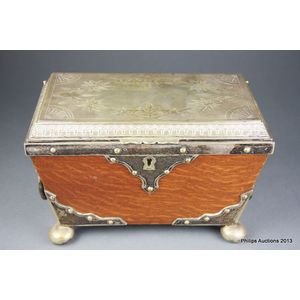Victorian Oak Tea Caddy with Silver Plate Mounts
A late Victorian silver plate mounted oak tea caddy, late 19th century, of sarcophagus form with a hinged top enclosing two compartments with covers, the metal cover engraved with bamboo and foliate designs, the body with decoratively shaped mounts throughout and a pair of lion mask ring handles to the sides, on ball feet. Height 13.5 cm. Width 12.5 cm. Depth 13.5 cm
You must be a subscriber, and be logged in to view price and dealer details.
Subscribe Now to view actual auction price for this item
When you subscribe, you have the option of setting the currency in which to display prices to $Au, $US, $NZ or Stg.
This item has been sold, and the description, image and price are for reference purposes only.
- Victorian Period - The Victorian period of furniture and decorative arts design covers the reign of Queen Victoria from 1837 to 1901. There was not one dominant style of furniture in the Victorian period. Designers used and modified many historical styles such as Gothic, Tudor, Elizabethan, English Rococo, Neoclassical and others, although use of some styles, such as English Rococo and Gothic tended to dominate the furniture manufacture of the period.
The Victorian period was preceded by the Regency and William IV periods, and followed by the Edwardian period, named for Edward VII (1841 ? 1910) who was King of the United Kingdom and the British Dominions and Emperor of India for the brief period from 1901 until his death in 1910. - Oak - Native to Europe and England, oak has been used for joinery, furniture and building since the beginning of the medieval civilisation. It is a pale yellow in colour when freshly cut and darkens with age to a mid brown colour.
Oak as a furniture timber was superceded by walnut in the 17th century, and in the 18th century by mahogany,
Semi-fossilised bog oak is black in colour, and is found in peat bogs where the trees have fallen and been preserved from decay by the bog. It is used for jewellery and small carved trinkets.
Pollard oak is taken from an oak that has been regularly pollarded, that is the upper branches have been removed at the top of the trunk, result that new branches would appear, and over time the top would become ball-like. . When harvested and sawn, the timber displays a continuous surface of knotty circles. The timber was scarce and expensive and was used in more expensive pieces of furniture in the Regency and Victorian periods. - Foliate - Decorated with leaves or leaf-like forms.
- Lion Mask - The lion mask has been used for centuries in various forms of art and design, including furniture, silver, and ceramics, and is usually y depicted as a stylized representation of the face of a lion, often with an open mouth and protruding tongue. and is often used as a handle, knob, or other decorative element.
In furniture design, lion masks were popular in the neoclassical and Empire styles of the late 18th and early 19th centuries. They were often used as decorative elements on the legs or arms of chairs, as well as on cabinet and drawer pulls. It was also used as a handle, knob, or other decorative element.
In silverware design, lion masks were often applied to tea and coffee pots, as well as on candlesticks, snuff boxes, and other small silver items. The lion mask was often used in combination with other neoclassical motifs, such as laurel wreaths or acanthus leaves, to create a sense of grandeur and classical elegance.
In ceramics, lion masks were often depicted in relief, and were sometimes used in combination with other decorative elements, such as garlands or swags.
This item has been included into following indexes:
-
tea caddies, material
- pollard oak 16
- silver plate 38
- tea caddies, period or age - Victorian 190
Visually similar items

Good Victorian tea caddy c1880, with ornate silver plate mounts and ram head handles on four bun feet, width 23 cm x depth 14 cm x height 13 cm
Sold by
in
for
You can display prices in $Au, $US, $NZ or Stg.

Brass bound Kuwaiti lift top trunk with ornate brass panels & decoration, 110 cm long, 49 cm deep, 47 cm high
Sold by
in
for
You can display prices in $Au, $US, $NZ or Stg.

Chinese carved camphor wood trunk 100 cm wide, 43 cm high
Sold by
in
for
You can display prices in $Au, $US, $NZ or Stg.

Victorian papier mache jewellery cabinet
Sold by
in
for
You can display prices in $Au, $US, $NZ or Stg.
